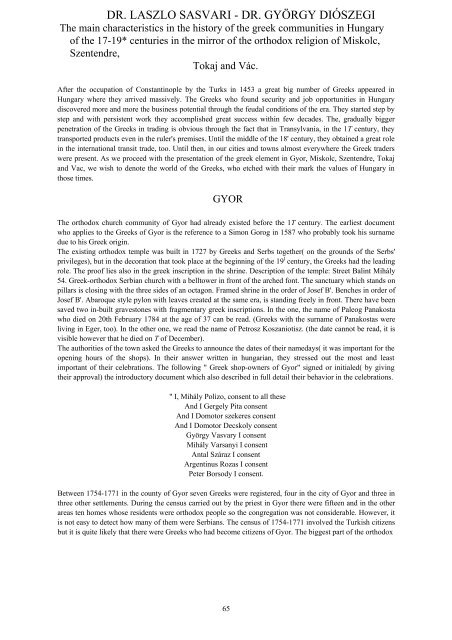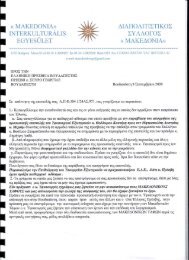Görög Örökség Ελληνική Κληρονομιά - H-ellin.com
Görög Örökség Ελληνική Κληρονομιά - H-ellin.com
Görög Örökség Ελληνική Κληρονομιά - H-ellin.com
Create successful ePaper yourself
Turn your PDF publications into a flip-book with our unique Google optimized e-Paper software.
DR. LASZLO SASVARI - DR. GYÖRGY DIÓSZEGI<br />
The main characteristics in the history of the greek <strong>com</strong>munities in Hungary<br />
of the 17-19* centuries in the mirror of the orthodox religion of Miskolc,<br />
Szentendre,<br />
Tokaj and Vác.<br />
After the occupation of Constantinople by the Turks in 1453 a great big number of Greeks appeared in<br />
Hungary where they arrived massively. The Greeks who found security and job opportunities in Hungary<br />
discovered more and more the business potential through the feudal conditions of the era. They started step by<br />
step and with persistent work they ac<strong>com</strong>plished great success within few decades. The, gradually bigger<br />
penetration of the Greeks in trading is obvious through the fact that in Transylvania, in the 1Τ century, they<br />
transported products even in the ruler's premises. Until the middle of the 18' century, they obtained a great role<br />
in the international transit trade, too. Until then, in our cities and towns almost everywhere the Greek traders<br />
were present. As we proceed with the presentation of the greek element in Gyor, Miskolc, Szentendre, Tokaj<br />
and Vac, we wish to denote the world of the Greeks, who etched with their mark the values of Hungary in<br />
those times.<br />
GYOR<br />
The orthodox church <strong>com</strong>munity of Gyor had already existed before the 1Τ century. The earliest document<br />
who applies to the Greeks of Gyor is the reference to a Simon Gorog in 1587 who probably took his surname<br />
due to his Greek origin.<br />
The existing orthodox temple was built in 1727 by Greeks and Serbs together( on the grounds of the Serbs'<br />
privileges), but in the decoration that took place at the beginning of the 19 l century, the Greeks had the leading<br />
role. The proof lies also in the greek inscription in the shrine. Description of the temple: Street Balint Mihály<br />
54. Greek-orthodox Serbian church with a belltower in front of the arched font. The sanctuary which stands on<br />
pillars is closing with the three sides of an octagon. Framed shrine in the order of Josef B'. Benches in order of<br />
Josef B'. Abaroque style pylon with leaves created at the same era, is standing freely in front. There have been<br />
saved two in-built gravestones with fragmentary greek inscriptions. In the one, the name of Paleog Panakosta<br />
who died on 20th February 1784 at the age of 37 can be read. (Greeks with the surname of Panakostas were<br />
living in Eger, too). In the other one, we read the name of Petrosz Koszaniotisz. (the date cannot be read, it is<br />
visible however that he died on Τ of December).<br />
The authorities of the town asked the Greeks to announce the dates of their namedays( it was important for the<br />
opening hours of the shops). In their answer written in hungarian, they stressed out the most and least<br />
important of their celebrations. The following " Greek shop-owners of Gyor" signed or initialed( by giving<br />
their approval) the introductory document which also described in full detail their behavior in the celebrations.<br />
" I, Mihály Polizo, consent to all these<br />
And I Gergely Pita consent<br />
And I Domotor szekeres consent<br />
And I Domotor Decskoly consent<br />
György Vasvary I consent<br />
Mihály Varsanyi I consent<br />
Antal Száraz I consent<br />
Argentinus Rozas I consent<br />
Peter Borsody I consent.<br />
Between 1754-1771 in the county of Gyor seven Greeks were registered, four in the city of Gyor and three in<br />
three other settlements. During the census carried out by the priest in Gyor there were fifteen and in the other<br />
areas ten homes whose residents were orthodox people so the congregation was not considerable. However, it<br />
is not easy to detect how many of them were Serbians. The census of 1754-1771 involved the Turkish citizens<br />
but it is quite likely that there were Greeks who had be<strong>com</strong>e citizens of Gyor. The biggest part of the orthodox<br />
65




